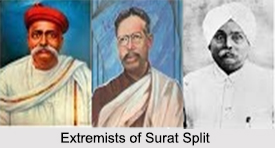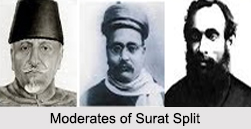 Surat Split is an important event in the modern history of India. It took place in 1907 when the Moderates parted company with the Extremists. The Extremist camp was led by Lal-Bal-Pal and the Moderate camp was led by Gopal Krishna Gokhle. The Moderates had controlled the congress from its very beginning and had their own ways of thinking and doing which were not acceptable to the younger generations who were impatient with the speed at which the moderates were moving and leading the nation. The congress met in an atmosphere of anger and resentment in this session. The differences between the two were inevitable and the split took place in the year 1907. The Surat Session was presided by Rash Behari Ghosh.
Surat Split is an important event in the modern history of India. It took place in 1907 when the Moderates parted company with the Extremists. The Extremist camp was led by Lal-Bal-Pal and the Moderate camp was led by Gopal Krishna Gokhle. The Moderates had controlled the congress from its very beginning and had their own ways of thinking and doing which were not acceptable to the younger generations who were impatient with the speed at which the moderates were moving and leading the nation. The congress met in an atmosphere of anger and resentment in this session. The differences between the two were inevitable and the split took place in the year 1907. The Surat Session was presided by Rash Behari Ghosh.
Reasons for the Surat Split
The split in the congress was due to many reasons. The fundamental differences between the moderates and the extremists were on the question of loyalty to the English throne and the continuance of British rule in India. The moderates had faith and believed in loyalty to the English throne. They also believed that the continuance of the British rule was in the interest of the people in India. On the other hand the extremists felt that the British rule was a curse and there should be no question of loyalty to the British throne.
 The emphasis on the ultimate goal and also the actual form of the ultimate goal was a point of differences between the extremists and the moderates. The moderates, believed in the policy of conciliation and compromise. They were not dissatisfied with the meagre concessions given by the British parliament to India from time to time. The extremists did not bother about the petty concessions given by the British government. They felt that Swaraj alone was the final remedy. The Moderates believed in adopting strictly constitutional methods for agitation and that also of the feeblest type so that there was not the slightest chance of any violence. They believed in reasoned and emotional appeals, lucid presentation of the case, irresistible statements of facts, irrefutable arguments and presenting petitions. The Moderates were not prepared to resort to a policy of non-cooperation or passive resistance. They did not accept even the programmes of Swadeshi whole heartedly. They considered "boycott" as a vindictive act which was liable to create a feeling of ill-will. On the other hand, the extremists believed that the national problems could not be solved by resorting to argument, ethics and piety and only a vigorous agitation could meet the need of the situation.
The emphasis on the ultimate goal and also the actual form of the ultimate goal was a point of differences between the extremists and the moderates. The moderates, believed in the policy of conciliation and compromise. They were not dissatisfied with the meagre concessions given by the British parliament to India from time to time. The extremists did not bother about the petty concessions given by the British government. They felt that Swaraj alone was the final remedy. The Moderates believed in adopting strictly constitutional methods for agitation and that also of the feeblest type so that there was not the slightest chance of any violence. They believed in reasoned and emotional appeals, lucid presentation of the case, irresistible statements of facts, irrefutable arguments and presenting petitions. The Moderates were not prepared to resort to a policy of non-cooperation or passive resistance. They did not accept even the programmes of Swadeshi whole heartedly. They considered "boycott" as a vindictive act which was liable to create a feeling of ill-will. On the other hand, the extremists believed that the national problems could not be solved by resorting to argument, ethics and piety and only a vigorous agitation could meet the need of the situation.
Another point of difference between the Moderates and Extremists was with regard to their approach and strategy. The Moderates depended for their success on the goodwill and sympathy of the Englishmen. However, the Extremists rejected such an approach and believed that the people of India were the masters of their own destiny and not any foreign powers. The Moderates believed that the people of India were still not fit for Self-Government. Whereas, the Extremists believed that the people of India were fit to rule themselves and self-government could not be denied to them on the ground of their unfitness. The Moderate believed that they would get what they asked for without any sufferings, the Extremists were of the definite view that the salvation of India was not possible without sufferings and self-sacrifice.
 On account of these differences, there were clashes between the Moderates and the Extremists which eventually led to the split. There is no denying of the fact that the Moderates were as much vehement in their denunciation of the partition of Bengal as the Extremists, but they had their own limitations and could not go beyond them. The Congress passed resolutions on boycott, Swadeshi and national education in 1906 but faced opposition from the Moderates. The Moderates did not approve of all that happened at the Calcutta Session of the Congress in 1906 and tried to undo the same at the next session in 1907 at Surat. The Extremists were not prepared to allow them to do so. Under the circumstances, an open clash between them was inevitable.
On account of these differences, there were clashes between the Moderates and the Extremists which eventually led to the split. There is no denying of the fact that the Moderates were as much vehement in their denunciation of the partition of Bengal as the Extremists, but they had their own limitations and could not go beyond them. The Congress passed resolutions on boycott, Swadeshi and national education in 1906 but faced opposition from the Moderates. The Moderates did not approve of all that happened at the Calcutta Session of the Congress in 1906 and tried to undo the same at the next session in 1907 at Surat. The Extremists were not prepared to allow them to do so. Under the circumstances, an open clash between them was inevitable.
Results of the Surat Split
This led to the significant decline of nationalism in India. The moderates after the Surat Split in 1907 demanded colonial self-government, as against the extremist demand of complete independence. The constitutional politics of the moderates had failed to impress the British government and that was amply reflected in the Morley-Minto Reforms of 1909. As a result, the moderate leaders had lost touch with the younger generation of nationalists who wanted to see the results and this was also the major cause of emergence of revolutionaries.
The Surat Split not only weakened the Indian National Congress, but it virtually destroyed its effectiveness till the Lucknow Session in 1916. For the next 8 years, India"s Nationalist Movement remained a house divided against itself, half constitutional and half revolutionary in aspiration.



















